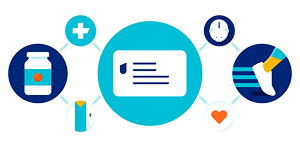A little bit of blood sugar (glucose) is a good thing. It provides fuel for your cells. But too much blood sugar is a problem. If it becomes too high, it can cause diabetes, a condition which affects tens of millions of Americans.
Among those over 65, roughly 3 in 10 have the disease, according to the American Diabetes Association. The best way to find out whether you’re at risk of developing diabetes is to get your blood sugar tested.
But what is a normal blood sugar reading (i.e., a normal range for glucose in your blood)? Keep reading for everything you need to know about this vital test.
Need a health plan for you or your family? Explore your options now, or contact a licensed insurance agent at 1-844-211-7730.
What kind of blood sugar tests can I take, and what’s a normal blood sugar reading?
A blood sugar test measures the amount of glucose, or sugar, in your blood. But not all tests are the same. Broadly speaking, blood sugar tests fall into 2 categories:
- Those your provider uses to screen you for diabetes
- Those you do yourself at home if you’ve already been diagnosed with diabetes
From there, the blood sugar tests break down even further, says Gary Scheiner, M.S. He’s a certified diabetes care and education specialist and clinical director at Integrated Diabetes Services in Wynnewood, Pennsylvania.
Here are the 3 main tests your doctor may use to check you for diabetes, along with guidance on reading the number, per the Centers for Disease Control and Prevention (CDC):
A1C test. This measures your average blood sugar level over the past 2 or 3 months.
- An A1C level below 5.7% is normal.
- A range between 5.7% and 6.4% indicates prediabetes. (That’s when you have higher than normal blood sugar, but it’s not high enough to be diabetes.)
- A level of 6.5% or higher means you have diabetes.
Fasting blood sugar test. This measures your blood sugar levels after a night of not eating.
- The healthy level is 99 milligrams per deciliter (mg/dL) or less. (That’s a unit of measure that shows the concentration of a substance in an amount of fluid.)
- A blood sugar range between 100 and 125 mg/dL indicates prediabetes.
- Higher than 125 ml/dL indicates that you have diabetes.
Random blood sugar test. This measures your blood sugar at any time.
- A blood sugar level of 140 mg/dL or lower is considered normal.
- A range of 140 to 199 mg/dL indicates prediabetes.
- A random blood test higher than 200 mg/dL indicates diabetes.
Are there blood sugar tests I can do at home?
In addition to tests you receive from a provider, there are tests you might take at home. These are generally used by people who already have diabetes, says Scheiner. There are 2 ways to do it:
Blood sugar meter (glucometer). For most glucometers, you’ll prick your finger, put a drop of blood on a test strip, then feed it into a small machine.
Continuous glucose monitor (CGM). This uses a sensor inserted under your skin to measure your blood sugar every few minutes. If you have a continuous glucose monitor, or CGM, you’ll still need to test daily with a blood sugar meter to make sure the readings are correct.
If you have diabetes, lower readings are generally better.
- The CDC recommends that you aim for 80 mg/dL to 130 mg/dL before a meal, and less than 180 mg/dL 2 hours after a meal.
- Scheiner, on the other hand, prefers an even lower reading. He recommends that his patients aim to keep their blood sugar under 140 mg/dL at all times.
In addition, Scheiner recommends testing periodically throughout the day. “A glucose monitor is great because you see the cause-effect relationship from other behaviors,” he explains. “It lets you know firsthand how different lifestyle choices impact blood sugar.”
Need a health plan to help manage your diabetes care and supplies? Explore your options now, or contact a licensed insurance agent at 1-844-211-7730.
What do I do if I have prediabetes?
If you’re diagnosed with prediabetes, don’t panic. “The chances are excellent that you can reverse it with behavior changes,” says Scheiner.
Case in point: A landmark study known as the Diabetes Prevention Program found that people with prediabetes could reduce their risk of type 2 diabetes by 31% if they took the diabetes medication metformin. And with the addition of lifestyle changes, they could reduce it even more.
Here’s what Scheiner recommends:
Eat right. A Mediterranean-style or vegan diet, which includes healthy foods, is good for achieving a healthy weight and improving the body’s sensitivity to insulin. According to the CDC, this is one of the most well-researched strategies for helping people with diabetes.
Here’s what to strive for:
- Focus on eating whole grains, beans, nuts, fruits and vegetables.
- Avoid processed meats, sugars and refined carbohydrates.
- Use extra-virgin olive oil instead of other fats.
Be more active. Regular exercise has been shown to help reverse prediabetes. The CDC recommends at least 150 minutes of moderate-intensity exercise per week.
“In addition to regular exercise, I encourage my patients to just focus on spending less time sitting — walk as much as possible and do your own chores like house cleaning and lawn work,” says Scheiner.
Get enough sleep. “If you don’t get enough sleep, your body produces more of certain hormones, such as ghrelin, that increase your appetite,” says Scheiner. “You’ll also overproduce more of the stress hormone cortisol, which raises your body’s glucose levels.”
Consider medication. The prescription drug metformin has been shown to help prevent the progression of prediabetes. “It’s very effective, it’s inexpensive, and it has very few side effects,” says Scheiner.
If these changes seem like a lot, try focusing on one at a time. For instance, maybe you start a daily exercise routine or commit to eating vegetables with every meal. Once the habit starts to feel natural, you can add more healthy habits to your routine.
In addition, Scheiner recommends seeking the help of a support and education program. You can find one near you through the CDC’s National Diabetes Prevention Program.
Need insurance but don’t want to wait to enroll? See if short-term medical is available in your state. Enter your ZIP code, or call a licensed insurance agent at 1-844-211-7730 to search plans.
Sources:
American Diabetes Association. “Statistics about diabetes.” November 2, 2023. Retrieved from https://diabetes.org/about-diabetes/statistics/about-diabetes
Centers for Diabetes Control and Prevention. “Diabetes tests.” February 28, 2023. Retrieved from https://www.cdc.gov/diabetes/basics/getting-tested.html
Centers for Diabetes Control and Prevention. “Get active!” November 3, 2022. Retrieved from https://www.cdc.gov/diabetes/managing/active.html
Centers for Diabetes and Prevention. “Healthy eating for people with diabetes.” December 6, 2022. Retrieved from https://www.cdc.gov/diabetes/library/features/mediterranean-style-eating.html
Centers for Diabetes and Prevention. “Manage blood sugar.” September 30, 2022. Retrieved from https://www.cdc.gov/diabetes/managing/manage-blood-sugar.html
Centers for Disease Control and Prevention. “The surprising truth about prediabetes.” July 7, 2022. Retrieved from https://www.cdc.gov/diabetes/library/features/truth-about-prediabetes.html
National Institute of Diabetes and Digestive and Kidney Diseases. “Diabetes Prevention Program (DPP).” May 2023. Retrieved from https://www.niddk.nih.gov/about-niddk/research-areas/diabetes/diabetes-prevention-program-dpp
Nature Reviews Endocrinology. “Metformin: update on mechanisms of action and repurposing potential.” May 2, 2023. Retrieved from https://www.nature.com/articles/s41574-023-00833-4
Compliance code:
50630-x-0524










